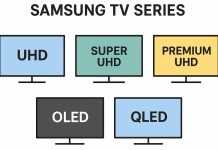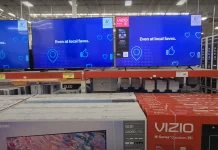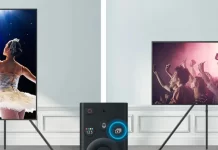What is Ambilight Philips TV
Ambilight is an acronym for Ambient Lighting, which means backlighting a monitor or TV. Philips was the first company to come up with the idea of ambient lighting around a TV or monitor. As you know, any idea, whether implemented or not, is patented, so Ambilight technology is patented by Philips. It is not available to other manufacturers of monitors or televisions. Or not even that, it is possible to negotiate with other manufacturers to use this technology for a royalty or fixed fee per device. But other companies don’t see the point, as I’ll discuss below.
How Ambilight works
LEDs are mounted on the back of the TV, usually using three primary colors, but now there are LEDs that have all three colors. The TV program analyzes the color gamut of the picture. This is actually quite easy to do. An additional program in the TV’s operating system controls the backlighting. The LEDs change their color and intensity depending on the brightness and color of the picture on the TV screen. The light emitted by the LEDs is projected onto the wall where the TV is mounted, or onto surrounding objects if the TV is on a nightstand.
Benefits of Ambilight
What it gives the viewer. When you watch TV, the screen becomes visually wider and brighter, so it adjusts to the room’s interior. In fact, the color of the backlighting automatically changes based on the image on the screen. This is called the Adaptive Color Backlighting feature, as they say in commercials, the backlighting always matches the image exactly – regardless of the color of your walls. You can adjust the backlighting settings to your liking. The effect is best achieved when the TV is on the wall.
Disadvantages of Ambilight
The disadvantages include several factors. The first disadvantage Ambilight works only in the dark, of course in daylight and artificial light also works. But no effect you will not see, because the brightness of external lighting is much brighter than backlighting. The second point, you can be annoyed by the constant change of not only the image, but also the backlighting.
Ambilight Generation technology
Ambilight technology has evolved, evolved and has 3 generations. After Philips gave up making televisions. Yes, you should know that all Philips TVs are now manufactured under license, by other companies.
The first generation is Ambilight.
Backlighting using multiple, usually two bulbs of backlighting. Used before the era of LEDs. Generally only light intensity was changed, in more expensive models the color palette was also changed.
Ambilight second generation.
Ambilight 2 is a two-channel backlighting. The backlighting changes depending on the prevailing color. The backlighting was chosen depending on the dominant color on the TV screen. If the screen was a picture of the sea, the backlight was blue, and if the movie scene was a sandy desert, it was yellow.
Third-generation Ambilight
This is where experimentation with different variations began
Ambilight Surround – three-channel backlighting is when the LEDs support three color channels, one LED has all three colors.
Ambilight Full Surround. In this variation, the screen is surrounded by backlighting on all sides, of course, backlighting on the back side of the screen. The screen is divided into zones, usually four zones, divide the TV screen into four parts, that’s four zones, the backlighting is adjusted depending on the predominant color in the zone. There is also additional backlighting on the TV stand. This solution makes the backlighting even softer.
Ambilight Spectra is a technology that creates a kind of three-dimensional image using LEDs. This modification technology uses an advanced microprocessor to track the colors and shapes of the screen and changes the backlighting around the TV, which expands the image on the screen, this from an advertisement. LEDs actually have diffuser lenses that direct the light from the backlight to the right places, for example there is no point in illuminating the space behind the TV.
Why other TV manufacturers don’t use Ambilight
Because the technology is licensed, you have to pay for it, and this fee will be included in the price of the TV. And there are a lot of competitors in the market right now, no one wants to increase the cost of the TV. Because of the disadvantages and limited use, there is little demand for this technology. Many Philips TV owners only used Ambilight a few times right after they bought their TV, and then the interest faded and they never turned Ambilight on again.






You’d better go to a service center
I bought a 40 in Philips TV & a 32 in TV. When I purchased them it said that when they went out, you don’t throw them out like the others. It said I could purchase New Light Bulbs. Where do I purchase the Light Bulbs for the 32 in.
Mrs. Woodley